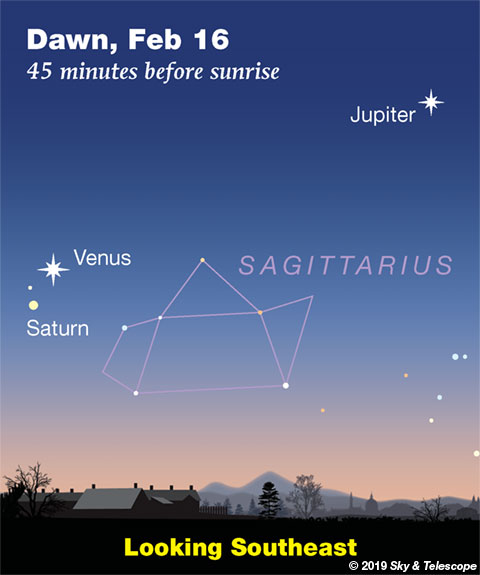
Friday, February 15
• The waxing gibbous Moon shines in the feet of Gemini this evening. Castor and Pollux are to its left, Procyon is to its lower left, and Orion is to its lower right.
Saturday, February 16
• Right after dark, the Moon finds itself between Procyon to its lower left and Pollux and Castor closer to its upper right. By 9 or 10 p.m. they're all higher in the south, and the arrangement will have turned vertical.
Sunday, February 17
• Now the evening Moon is below Pollux and Castor and left of Procyon.
• Have you ever seen Canopus, the second-brightest star after Sirius? It's almost due south of Sirius: by 36°. That's far enough south that it never appears above your horizon unless you're below latitude 37° N (southern Virginia, southern Missouri, central California). And there, you'll need a very flat south horizon. Canopus passes over the south point on your horizon just 21 minutes before Sirius does.
When to look? Canopus is due south when Beta Canis Majoris — Murzim the Announcer, the star about three finger-widths to the right of Sirius — is at its highest due south (roughly 8:00 p.m. now, depending on how far east or west you are in your time zone). Look straight down from Murzim then.
Monday, February 18
• Right after dark, bright Capella shines near the zenith. Face west-northwest and look 20° (two fists) toward that direction from Capella. The brightest star there is Alpha Persei, Mirfak. Around and upper left of it is the Perseus OB1 Association, a loose swarm of modestly bright stars about the size of your thumbtip at arm's length. They show well in binoculars.
• A momentary, partial asteroid occultation of Sirius should happen late tonight for well-placed observers along a very narrow path crossing southernmost South America, Panama, and possibly eastern Cuba and the southern Bahamas. This is very far east of the original prediction last week. See Bob King's Will Sirius Disappear on February 18th?
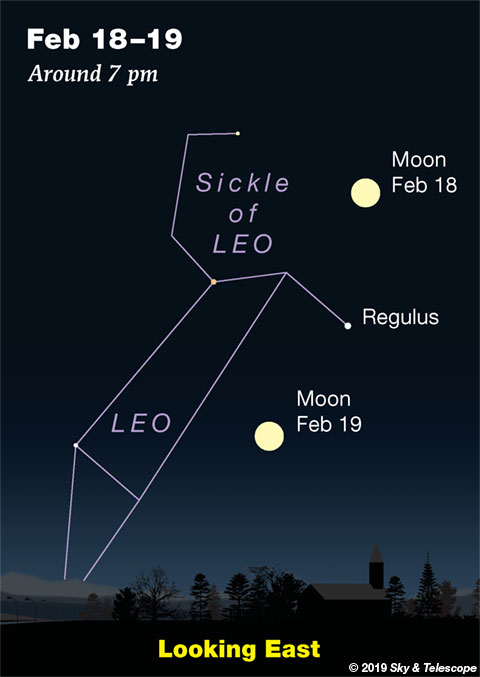
Tuesday, February 19
• The Full Moon (exact at 10:54 a.m.) shines in Leo tonight. This is a supermoon, a full moon at perigee (closest to Earth in the Moon's monthly orbit). It appears very sightly larger and brighter than average.
After dark look for Regulus upper right of the Moon, and pale orange Algieba (Gamma Leonis), a little fainter, above the Moon or to its upper left as shown here. These are the two brightest stars of Leo's Sickle.
Wednesday, February 20
• After dinnertime at this time of year, five carnivore constellations rise upright in a row from the northeast to south. They're all seen in profile with their noses pointed up and their feet (if any) to the right. These are Ursa Major the Big Bear in the northeast (with the Big Dipper its brightest part), Leo the Lion in the east, Hydra the Sea Serpent in the southeast, Canis Minor the Little Dog higher in the south-southeast, and bright Canis Major the Big Dog in the south.
Thursday, February 21
• After dark the Big Dipper stands on its handle in the northeast. In the northwest, Cassiopeia also stands on end — at about the same height.
• Sirius shines highest in the south in mid-evening now. Its faint white-dwarf companion, the first super-dense object ever discovered, is a notoriously difficult telescopic sighting. But for nearly a decade to come, Sirius B appears about as far from Sirius A as it ever does. And when Sirius is highest is the time to try. For tips on detecting it see Bob King's Sirius B — A New Pup in My Life.
And for more about this and other telescopic targets in Canis Major, turn to Sue French's Deep-Sky Wonders column in the February Sky & Telescope, page 54.
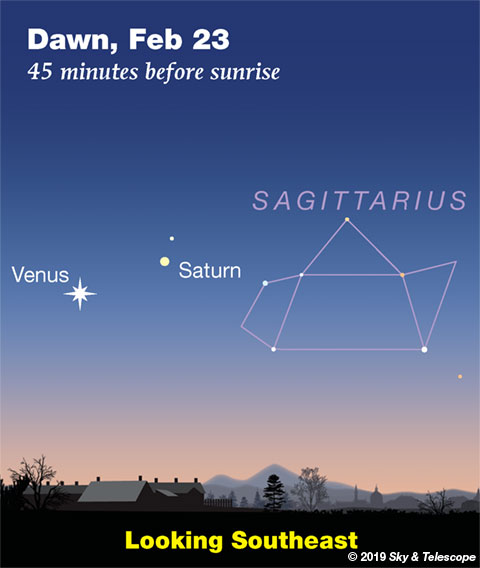
Friday, February 22
• Winter still has a month to go, but a preview of spring stars awaits if you step outside after about 11 p.m. By then the waning gibbous Moon will be up in the east tonight. Look for Spica to its lower right by about 7° (less than a fist at arm's length). Four times farther to the Moon's upper left shines brighter Arcturus, pale yellow-orange.
Saturday, February 23
• An easier Sirius sight: Using binoculars, examine the spot 4° south of Sirius (directly below it around 8 or 9 p.m. now). Four degrees is somewhat less than the width of a typical binocular's field of view. Can you see a little patch of speckly gray haze? That's the open star cluster M41, about 2,200 light-years away. Sirius, by comparison, is only 8.6 light-years away.
• These moonless evenings of late winter are an ideal time to look for the zodiacal light if you live in the mid-northern latitudes. Why? This is the time of year when the ecliptic tilts most steeply upward from the western horizon at nightfall.
From a clear, clean, dark location, look west at the very end of twilight for a vague but huge, tall pyramid of pearly light. It's tilted to the left, aligning along the constellations of the zodiac.
What you're seeing is sunlit interplanetary dust orbiting the Sun near the ecliptic plane. Believe it or not, seen from interstellar distances this would be the solar system's most prominent feature after the Sun itself; it's very big, making up for its dim surface brightness.
________________________
Want to become a better astronomer? Learn your way around the constellations. They're the key to locating everything fainter and deeper to hunt with binoculars or a telescope.
This is an outdoor nature hobby. For an easy-to-use constellation guide covering the whole evening sky, use the big monthly map in the center of each issue of Sky & Telescope, the essential guide to astronomy.

Once you get a telescope, to put it to good use you'll need a detailed, large-scale sky atlas (set of charts). The basic standard is the Pocket Sky Atlas (in either the original or Jumbo Edition), which shows stars to magnitude 7.6.
Next up is the larger and deeper Sky Atlas 2000.0, plotting stars to magnitude 8.5; nearly three times as many. The next up, once you know your way around, are the even larger Interstellarum atlas (stars to magnitude 9.5) and Uranometria 2000.0 (stars to magnitude 9.75). And read how to use sky charts with a telescope.
You'll also want a good deep-sky guidebook, such as Sue French's Deep-Sky Wonders collection (which includes its own charts), Sky Atlas 2000.0 Companion by Strong and Sinnott, or the bigger Night Sky Observer's Guide by Kepple and Sanner.
Can a computerized telescope replace charts? Not for beginners, I don't think, and not on mounts and tripods that are less than top-quality mechanically (meaning heavy and expensive). And as Terence Dickinson and Alan Dyer say in their Backyard Astronomer's Guide, "A full appreciation of the universe cannot come without developing the skills to find things in the sky and understanding how the sky works. This knowledge comes only by spending time under the stars with star maps in hand."
This Week's Planet Roundup
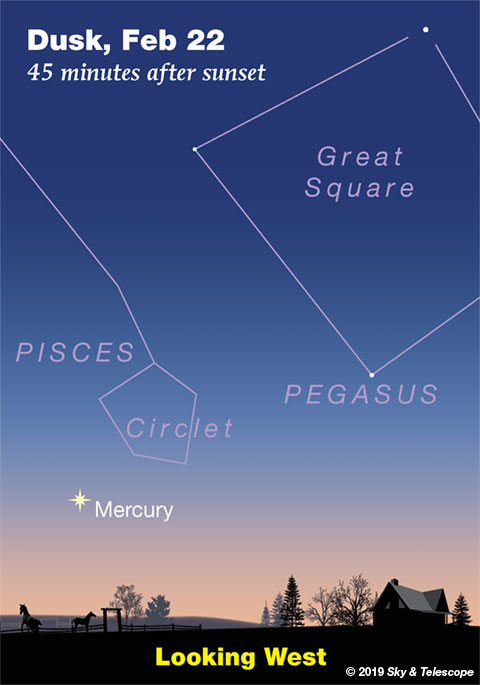
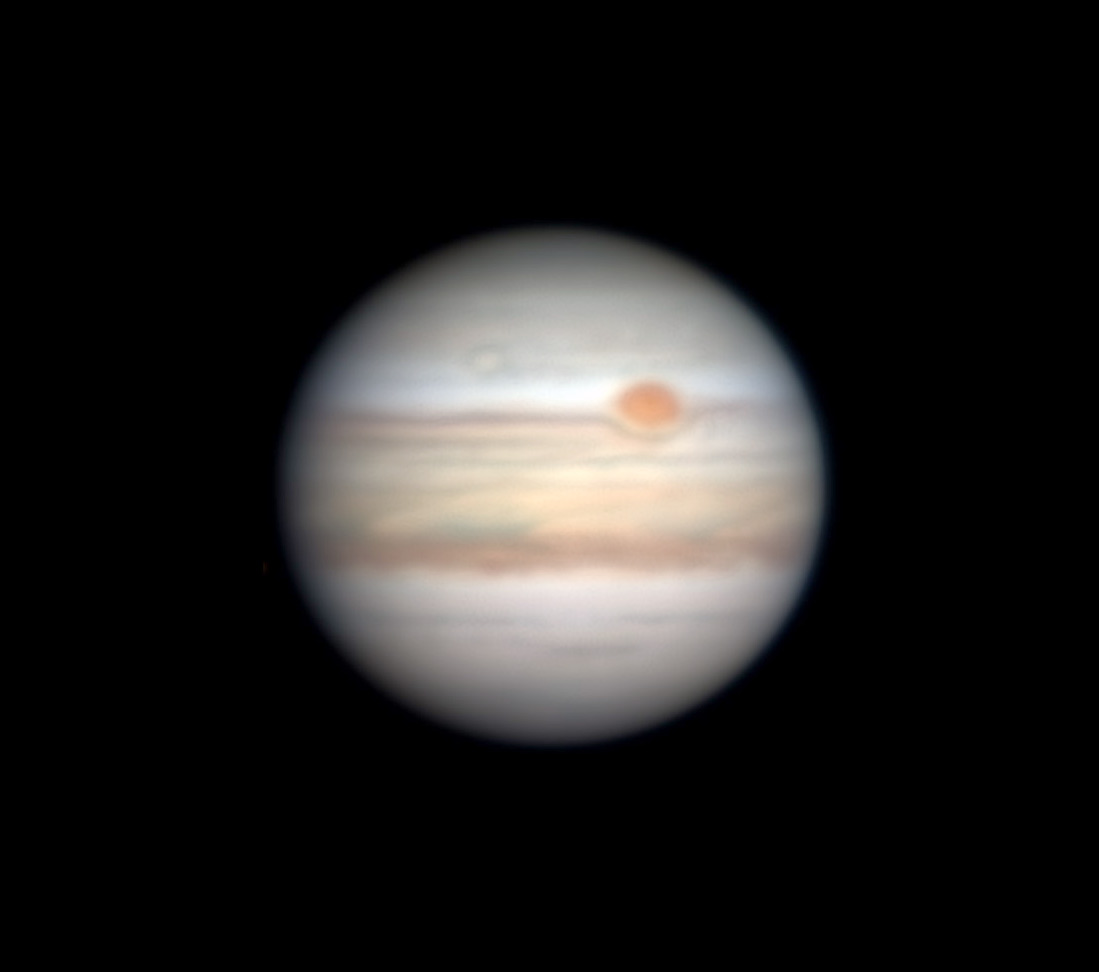
Mercury (about magnitude –1.0) is emerging into view low in the afterglow of sunset. It becomes a little higher and easier to spot every evening. About 30 to 45 minutes after sunset, look for it glimmering low a little south of due west, as shown here.
Venus (magnitude –4.2), Jupiter (magnitude –1.9) and Saturn (magnitude +0.6) all rise before the beginning of dawn. As dawn gets under way, Jupiter and Venus dominate the low southeast. Jupiter is the one on the upper right. Every morning they're a little farther apart. Meanwhile Saturn, much dimmer, passes close by Venus this week. They appear closest, 1.1° apart, on the morning of Monday the 18th.
And to the right of Jupiter look for twinkly orange Antares. They're 12° apart.
In a telescope Venus is dazzling white and gibbous. Jupiter appears twice as large in apparent diameter, but its surface brightness is some 50 times dimmer — due mostly to Jupiter's 7-times-greater distance from the illuminating Sun.
You might be surprised to learn that both planets have bright albedos. Jupiter's cloudtops reflect an average 52% of the sunlight that hits them while those of Venus reflect 65%. Pictures of Jupiter are rarely displayed in a way to show this fact; imagers (and websites and magazines) usually prefer to increase darkness and contrast to bring out details in Jupiter's clouds.
Mars (magnitude +1.1, in Aries) still glows high in the west-southwest at nightfall and sets around 11 p.m. In a telescope it's a tiny blob hardly 6 arcseconds wide.
Be patient. Not until October 2020 will Mars come to opposition again and swing (relatively) close by Earth.
Uranus (visible in binoculars at magnitude 5.8, at the Aries-Pisces border) is a few degrees below Mars. Finder chart (without Mars). Look right after dark while Mars and Uranus are still high.
Neptune is lost in the afterglow of sunset.
Damian Peach made this full-rotation composite of Jupiter from images he took last May around the time of Jupiter's opposition, using a 14-inch Schmidt-Cassegrain telescope on Barbados. North is up.
______________________
All descriptions that relate to your horizon — including the words up, down, right, and left — are written for the world's mid-northern latitudes. Descriptions that also depend on longitude (mainly Moon positions) are for North America.
Eastern Standard Time (EST) is Universal Time (UT or GMT) minus 5 hours.
______________________
Audio sky tour. Out under the evening sky with your earbuds in place, listen to Kelly Beatty's monthly podcast tour of the heavens above. It's free.
______________________
"Science is built up of facts, as a house is with stones. But a collection of facts is no more a science than a heap of stones is a house."
— Henri Poincaré (1854–1912)
______________________
 7
7








Comments
Rod
February 17, 2019 at 8:32 am
The Saturday 16th forecast for the Moon is what I viewed last night in Maryland. Clear skies with temps near 0C. I was out from 2130 to 2230 EST or 9:30-10:30 PM. The waxing gibbous Moon was up high in Gemini and I could see using my 10x50 binoculars, M44 open cluster in Cancer. I viewed with the telescope too (Telrad used to locate). Using a moon filter, I enjoyed some views at 31x to 129x along the terminator line and craters visible. Aristarchus crater very good view, and Philolaus crater in north limb. Many craters in the south limb of the Moon. Tycho crater very good views and Clavius crater in south-west quadrant too. Earth's rotation very obvious while viewing the Moon near 129x, frequent adjustments to keep the Moon centered in FoV. The fields and woods all around were lit up by the Moon nearly 91% illuminated. The Moon's apparent magnitude listed near -12.30, M44 about +3.46. The Moon was some 2 million times brighter than M44 🙂 Mary beth - how was your view in Houston?
You must be logged in to post a comment.
Curt Renz
February 18, 2019 at 11:13 am
Not Alan thankfully, but several other popular science authors are referring to the Full Moon coming during the morning of 2019 FEB 19 as not only the widest (angular measurement) so-called Super Moon in the current series of three, but also as the brightest Moon of the year. Actually the Full Moon last month was the brightest Moon since 2001 and until 2096. That peak was reached just as it left the Earth’s penumbra following a Lunar Eclipse. I calculated this with use of a Jean Meeus algorithm. For brightness, not only must nearness to Earth be considered, but also nearness to Sun and nearness to Anti-Solar Point. Full Moons just outside the penumbra near the time of an eclipse often are brighter than a Super Moon. This is due to the intensity of the Oppositional Flash being a significant factor. Many writers apparently assume that only nearness to Earth is what matters for Full Moon brightness.
You must be logged in to post a comment.
Rod
February 18, 2019 at 11:34 am
Curt, some good info on the Moon's brightness. My comments are based upon Stellarium 0.18.3 and Starry Night apparent magnitudes presented for different phases and distances from Earth. I also work with Virtual Moon Atlas. I check against the monthly publications in Sky & Telescope for Lunar Almanac, like angular size and distance from Earth. Usually I find that the Moon's angular size from perigee to apogee does not vary much, about 4 arcminute size or so - generally too small a difference for unaided eye views but telescopes and imaging equipment show the changes. Some of my views of the Moon use a 14-mm eyepiece that provides 71x view with 1-degree true field of view. I enjoyed the total lunar eclipse in Cancer back in January using this eyepiece - breath taking views.
You must be logged in to post a comment.
mary beth
February 18, 2019 at 2:29 pm
Good afternoon Rod sounds like you’ve had some nice viewing. Only a couple of clear nights since I posted last. I think will have rain tomorrow night so I won’t get to enjoy the snow moon. I was out late last night and saw Arcturus for the first time this year, it was so golden orange and beautiful about 11;30 last night. Thoroughly enjoy watching it track across the sky until November. Also it’s been nice to see regulus in algebra. As you can tell I can only see really bright starts here because of the light pollution. Looking forward to your report on the moon tomorrow night! Hopefully things will start warming up for you! So much to look forward to in the spring and summer!
You must be logged in to post a comment.
Rod
February 18, 2019 at 3:29 pm
mary beth, I may not be viewing the Full Moon tomorrow night :). We have a winter storm watch posted for the area now from 2200 EST on Tuesday night until Wednesday night, 2200 EST. Looks like 6 inches or more of snow coming so perhaps I will see a *snow moon* instead 🙂 Arcturus is a good star to observe and I like it in spring skies.
You must be logged in to post a comment.
Rod
February 18, 2019 at 10:20 pm
I did get out and view the Moon again tonight, waxing eloquently in Leo from 1930-2030 EST and temps near 1C. Space.com reports supermoon coming tomorrow and Full Snow Moon 🙂 NWS EMI (Westminster) station reported winds aloft in Maryland area tonight, 6000 at 310/40 kts, FL180 at 270/131 kts, and FL 300 at 260/169 kts. Viewing the Moon tonight at 71x with 1-degree true field of view (FoV), ethereal with clouds moving rapidly by and much surface detail visible in my telescope using moon filter. I chiefly examined the craters Tycho, Schickard, Grimaldi, Riccioli, and Copernicus. The waxing gibbous Moon about 99.5% illuminated. Viewing at 71x with 1-degree true FoV or about 60' diameter, the Moon was close to 34' size in the eyepiece. The views tonight would make for a good video with rapidly moving clouds (cumulus, altocumulus, cirrus) passing by the nearly Full Moon with much surface detail visible and Maria in the eyepiece. I likely will not see the *Full Snow Moon* or Supermoon tomorrow night but this evening was enjoyable.
You must be logged in to post a comment.
mary beth
February 19, 2019 at 7:13 pm
Hi Rod I hope y’all are enjoying a cozy snowy evening! It’s a little bit chilly and rainy here. I guess neither of us will be able to report on the moon but maybe someone else will post. Good night for hot chocolate!
You must be logged in to post a comment.
You must be logged in to post a comment.